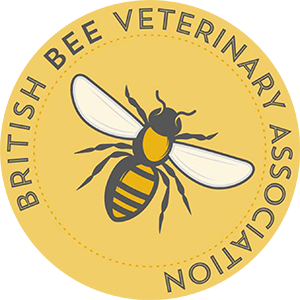



The Bee Friendly Practice Scheme.
People love bees. They are part of our culture and woven into the fabric of civilisation in so many ways right through from earliest times. A symbol of hard work and cooperation resulting in producing one of the most sought-after foods, honey, whilst fulfilling one of the most important processes in the natural world, pollination.
The British Bee Veterinary Association wishes to spread knowledge of bees and other pollinators to the profession and your clients. We would like to make your practice “Bee Friendly” by sending you a pack containing materials which will highlight bees on your premises. These include, posters, sticky labels for children, window stickers, Californian poppy seeds, flower bed label, BBVA mouse mat and more. Your clients will appreciate that you have a wish to help creatures provide a vital service to the natural world.
We have chosen Californian Poppy seeds because they are easy to grow and provide beautiful colours to brighten up your surgery . There is always an area where bee friendly plants can be grown, outside flower bed, round the carpark, containers, window boxes. Flowers will provide vital nectar and pollen for bees and provide a welcome splash of colour to the surgery. These flowers can be grown anywhere even in the inner-city clinics.
Bees face three major challenges, firstly, loss of habitat with resultant reduction in food supply, secondly, use of pesticides and agrochemicals, thirdly, pests and diseases.
97% of wildflower meadows have disappeared in UK because of intensive agriculture. The destruction of hedgerows continues to make larger fields which promote monoculture on a greater scale. Governments are still giving grants to promote this destruction of established habitats. The extensive use of herbicides has meant that the wildflower population has reduced dramatically coupled with the destruction of established trees in hedgerows so that it is now very difficult to keep bees in the rural environment. Beekeepers call it “the green desert”. It is much easier to keep bees in an urban or suburban environment because of garden flowers. Gardens provide a wide variety of flowers and in succession so as they give a continuous supply of food throughout the year. Next time you are in the country, have a look across the fields and the only colour you will see is green. Some crops do provide colour such as the yellow of oil seed rape flower, but this only lasts for a few weeks and then the bees must find another source of food.
Bees are very busy as we know but how busy. To make one pound of honey, bees must visit up to two million flowers to collect the nectar and process it into honey or roughly four million per kilo. For one year an average hive will make up to 150 kilos of honey. Do the maths and that is a lot of flowers that need to be visited. Why do they make so much honey? About 25 to 30 kilos is stored for use in winter. The rest is used a fuel during the rest of the year. Honeybees maintain a constant temperature within the hive at 35 degrees centigrade, morning, noon and night from January to November when brood is being reared. The queen rests for 6-8 weeks in winter in the middle of a cluster and the temperature can drop a few degrees. It takes a lot of energy to thermoregulate the hive.
Pesticides have been used in agriculture since the 1940s with the introduction of DDT, an organochlorine. The industry has passed on through the organochlorines, organophosphates, permethrins and now neonicotinoids. Neonicotinoids are highly toxic to insects on land and in water. The dose of DDT that would kill a bee, the equivalent dose of neonicotinoid would kill 27,000 bees. They have proved to be detrimental to bumblebees and solitary bees, very important contributors to the pollinator force. “Neonic” effect in honeybees is that it affects the central nervous system and interferes with their navigation so as they cannot return to the hive and are lost.
Pests and diseases have increased worldwide for honeybees due often the beekeepers and international trade and travel. Varroa mites once only found on the Eastern honey bee Apis cerana mutated and jumped to the Western honeybee which had no natural resistance. They suck nutrients from the bee and introduce viruses which make the bees very sick. One virus, deformed wing virus, DMV, has become very common and has resulted in the collapse of many colonies due to the infection. Varroa destructor mite has spread worldwide except Australia and has decimated the wild, feral colonies of bees. This huge resource and genetic pool has been severely reduced in most countries.
Small hive beetle is a serious threat as its larva is a voracious eater of honeybee comb, larvae, honey and pollen. It was accidentally introduced into Florida in 1998 and killed 20,000 colonies in two years. It has spread through the US and has reached Canada. It was found in Southern Italy in 2014(?) and the Italian authorities are doing their best to eradicate it.
The Asian hornet, Vespa velutina, was accidentally introduced to south west France in 2004 and has spread into neighbouring countries heading rapidly for eastern Europe. This is a top predator which prefers honeybees but will eat other insects. Apart from the predation on bees the hornets harass the colonies and reduce flights which means that many colonies die of starvation. There have been several Asian Hornet nests found in Britain and s insect from establishing itself in Britain and Ireland. Veterinary practices would be ideally placed to assist in the identification of Asian Hornets and report sightings.
Bees were brought sharply before the public’s consciousness in 2007 as a result of a strange phenomenon dubbed Colony Collapse Disorder or CCD. They have stayed centre stage ever since. They feature in the recent UN Report on Biodiversity which highlights the reduction in over one million species including many insects are in danger of extinction. For example biomass of insects in Germany reduced by 76% between 1989 and 2016.
There is so much that the veterinary profession can do to help these important creatures. Asking practices and clients to plant bee friendly flowers to provide food for bees is a significant step towards helping the environment. Let us help you to raise awareness of bees within your practice and your clients. Apply for a free pack from the British Bee Veterinary Association today. Apply to president@britishbeevets.com
John Hill MRCVS
President British Bee Veterinary Association